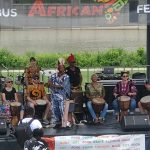By Narayan Phuyal Sharma

Writing in 1821, Heinrich Heine, a German-Jewish poet suggested an intrinsic link between mass human slaughter and attacks on cultural heritage when he wrote “Where they have burned books, they will end burning human beings.” Ironically, his own books were burned by the Nazis more than a century later in defense of Volksgeist, the spirit of German nationalism.That clearly set the stage for the holocaust.
Decades later, Nepali and Sanskrit books were burned in Bhutan, in defense of the Drukpa national spirit: One Nation, One People. This homogenizing nationalism led to expulsion of about 20% of the country’s citizens, mainly the Nepali speakers.
Although the term genocide was coined to represent “the methodical, merciless butchery” of the Jews- the holocaust- and similar others, attack on or obliteration of culture(s) is still “a crime without a name.’
Characterized by several genocidal incidences in history, the April month has a historical signification towards understanding the crime of genocide in all its manifestations. It is therefore marked as Genocide Awareness Month.
The Armenian genocide began in April of 1915 as the Ottoman regime began its extermination campaign of ethnic Armenians. In April 1933, the Nazis legislated its first anti-Semitic policy leading to the holocaust. Likewise, in the April of 1975, Khmer Rouge captured Cambodia that followed the massacre of about two million people in the course of the next four years. Most part of Anfal genocide that slaughtered about 182,000 Iraqi Kurds fell in April of 1988. The siege of Sarajevo in Bosnia in the April of 1992 subsequently witnessed the massacre of 10,000 people including 1,500 children. The Darfur genocide that oversaw the gory carnage of over 400,000 Darfuri civilians began in April of 2003 marking the first instance of this (in)human barbarism of the 21st century.
Ironically, genocide continues being perpetrated despite the international community committing on preventing its recurrence after the lurid holocaust experience. Distinguished as the first human rights treaty adopted by the General Assembly of the United Nations on December 9, 1948, the Convention on the Prevention and Punishment of the Crime of Genocide (Genocide Convention), reflects the intent of the World community to prevent its recurrence. With 152 state parties as of 2019, the Genocide Convention is treated as peremptory norm of international law, one among few other treaties considered inviolable, from which no derogation is permissible.
The Convention defines the crime of genocide as certain “acts committed with intent to destroy, in whole or in part, a national, ethnical, racial or religious group.”
The phrase “acts committed with intent to destroy” consists of two separate elements of crime for an act to amount to genocide: mens rea (guilty mind) and actus reus (guilty act). Therefore, commission of mere ‘acts’ is not sufficient without the intent element.
Article II of the convention lists certain ‘acts’ that would amount to genocide if the ‘intent’ element is met. The ‘acts’ include killing members of the group; causing bodily or mental harm; deliberately inflicting conditions of life calculated to bring about physical destruction in whole or in part; imposing measures to prevent birth within the group and forcibly transferring children of the targeted group to another.
The convention definition is restrictive, confining itself to deliberate physical destruction of the target group as against attack on the group’s existence involving persecution on its culture or even ‘acts’ of ethnic cleansing.
The statutes of ad hoc tribunals for the former Yugoslavia and Rwanda as also Rome Statute of International Criminal Court consign to this restrictive definition.
However, the term genocide was originally meant to be expansive. Raphael Lemkin, a polish Lawyer of Jewish origin who coined the neologism ‘genocide’ combining Greek ‘Genos’ (tribe, race,) and Latin ‘Cide’ (killing) intended a broad definition. In his capacity as an expert and advocate in negotiating the Genocide Convention, he proposed three constitutive elements as essential to the crime of genocide: physical, biological and cultural.
The physical and the biological aspects reflect in different degrees of precision in the Genocide Convention. The cultural aspect, however, was altogether excluded in the treaty and discussions on reasons thereto go beyond the scope of this paper. Suffice it to say that some states that wielded power during the negotiation and drafting process of the convention had their fair share of sins to conceal.
Lemkin, who viewed attack on cultural heritage as a form of genocide, and precursor thereof, lamented echoing HeinrichHeine: “first they burn books and then they start burning bodies.”
Emphasizing on the cultural aspect, Lemkin argued that genocide was effected by a synchronized attack on eight aspects of the targeted people’s lives: political, social, cultural, economic, biological, physical, religious and moral. Cultural aspects of genocide, as Lemkin suggests included “prohibiting or destroying cultural institutions and cultural activities…forbidding the use of the (target) group’s language…banning or discouraging liberal arts in education…rigid control of all cultural activities,” among others. The objective of such acts was to ensure “disintegration of …culture, language…religion and economic existence of national groups, and the destruction of the personal security, liberty, health, dignity and even the lives of individuals belonging to such groups.”
How does Bhutan’s “One Nation, One People” philosophy relate with Lemkin’s idea of cultural genocide? The Drukpa regime did effectuate a “synchronized attack on different aspects” of the life of Nepali speaking Bhutanese, to borrow Lemkin’s terminology.
The Drukpa regime began its first formal interference on the religious life of the Nepali speaking Bhutanese, mainly Hindus, in the very first session of the Bhutanese parliament in 1953.The parliament’s resolution stated that “His Majesty was pleased to command the establishment of a Monk Body…in the Nepali villages in Southern Bhutan,” “with an aim of converting the Nepalese of southern Bhutan into Buddhism.”
While the international standard on religion is based on individual freedom as the Universal Declaration of Human Rights (UDHR, 1948) or International Covenant on Civil and Political Rights (ICCPR, 1966) envisage, Bhutan’s regime began its first legislative stint by invading that very freedom of a religious group. Seen from an American perspective, this 1953 resolution of the Bhutan’s parliament legitimized what the first amendment to the US constitution prohibited in 1791.
What began as a soft policy in 1953 became the cornerstone of Bhutan’s nationalism by the 1980’s. Bhutan’s Drukpa nationalism thrived on obliterating the ‘other’ through state sponsored coercion, assimilative measures, outright marginalization, exclusion or even expulsion. It is a formally proclaimed national agenda, that Bhutan being the ‘Druk’, every other culture had to be subsumed within the Drukpa culture: One Nation, One People.
Lemkin’s warning is prophetic in Bhutan’s case. The Drukpa regime did actually burn Nepali and Sanskrit books and banned the language from school curricula. All forms of cultural attires are prohibited and replaced by Drukpa national dress. Driglamnamzag, ‘a national culture’ based on Drukpa values warrants observation of a homogenous social protocol while replacing values and cultures of the ‘other.’ The Drukpa architecture has wholly invaded most of the few Hindu temples as names of places symbolic of Nepali culture have been assigned Drukpa nomenclature. Through a massive population transfer, the Northern Bhutanese is also the new ‘Southern Bhutanese’.
The Constitution is not free of institutional bias. Although Druk Gyalpo is envisioned as the protector of all religions under Article 3 (2) of the constitution, the Drukpa religious institutions receive preferential treatment under Article 3(7) where the “Zhung Dratshang and Rabdeys…” receive “adequate funds and other facilities from the state.” This is just one case of the constitution institutionalizing Drukpa nationalism.
By forcefully exiling at least half of the Nepali speaking citizens, the government has effectively silenced the rest to submission. The Nepali speaking Bhutanese is thoroughly deculturized and de-historicized. As the situation stands currently, the new Nepali language is now ‘Lhotshamkha’, as the ‘Lhotshampa’ -the ultimate remnant of the cultural Nepali in Bhutan- submits helplessly to the Drukpa juggernaut of One Nation, One people.
It is relevant, as April begins, to understand genocide in all its forms, including its softer, subtler, cultural dimensions. To do so in the case of Bhutan, now a puritanical Drukpa nation, one must focus beyond the façade of the orchestrated image of an infallible hermit kingdom.
As genocide awareness month, April must summon our attention towards understanding genocide in all its manifestations and invoke our conscience against the savagery it constitutes.
_______
Narayan Phuyal Sharma: The author is a Juris Doctor (JD) candidate at Drexel University’s Thomas R Kline School of Law and volunteers as the research director at The Bhutan Research and Information Network (The BRAIN), a Pennsylvania based non-profit Organization. The opinions expressed herein are author’s personal. This article was first published in Bhutan News Service (BNS).
Support the New Americans magazine to continue to serve our community with precise news that affect the new American, immigrant and refugee community. https://paypal.com/donate/?hosted_button_id=8LHFS78NRNJJY&source=url


































Leave a Reply
You must be logged in to post a comment.